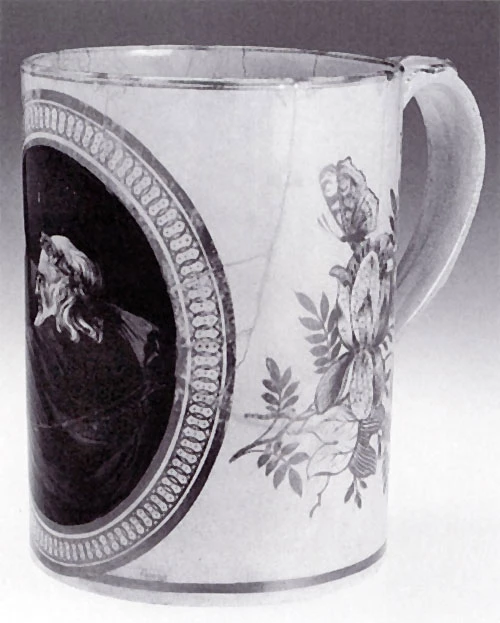The W. J. Grant-Davidson gift of Swansea and English pottery
In 1994, forty pieces of pottery and porcelain were given to Amgueddfa Cymru. They were the gift of W. J. Grant-Davidson a distinguished historian of the Welsh potteries. Amongst the collection were several unique and important items, manufactured in Swansea in the early 19th century.
The Swansea earthenware tankard by William Weston Young.
Generous gifts
One of the most interesting pieces is a large earthenware tankard. It was made at the Cambrian Pottery, Swansea, in the opening years of the 19th century. It is decorated with the head and shoulders of a druid. We can tell from the inscription that this was painted by William Weston Young (1776-1847). The decoration is unique, though Weston Young also painted a plaque with a druid cutting mistletoe (now in the Victoria and Albert Museum, London).
William Weston Young
William Weston Young worked at the pottery from 1803 until 1806 as a painter and as assistant to the owner, Lewis Weston Dillwyn. A land surveyor by profession, Weston Young was subsequently a partner in the Nantgarw China Works.
A pictorial puzzle
Other household items in the collection include a milk-pan, egg cups and a jug inscribed 'John Jinken 1793'. There is also a punchbowl decorated with a swan and a pike. This may have been made especially for the Pike family, who came from Dorset and shipped clay to Swansea. An image used as a pun like this is called a rebus.
Pioneer potter
Mr Grant-Davidson was also interested in English ceramics. There are ten examples from the mid 18th century in the collection he gave to the museum. As well as three fine Staffordshire stoneware teapots, there are two documentary pieces of Josiah Wedgwood's creamware. The collection includes one of the four known pieces of manganese decorated creamware, made by the potter Enoch Booth. Made in the first half of the 1740s, these may be the earliest examples of an earthenware body which is one of Britain's principal contributions to ceramic history.
Historian and collector
W. J Grant-Davidson was a distinguished historian of the Welsh potteries. He collected British ceramics from the late Middle Ages to the early 20th century. His best known publications are the article 'Early Swansea Pottery, 1764 - 1810' and the book ‘The Pottery of South Wales’. These feature many pieces from his collection.

Comments - (4)
Thank you very much for your enquiry. I have passed it on to our Art Department, who will be in touch in due course.
Best wishes,
Marc
Digital Team
Thanks
Peter Child
Hi there Gloria,
I will pass on your enquiry to our Art Department, who will be in touch in due course.
Many thanks for your enquiry,
Sara
Digital Team